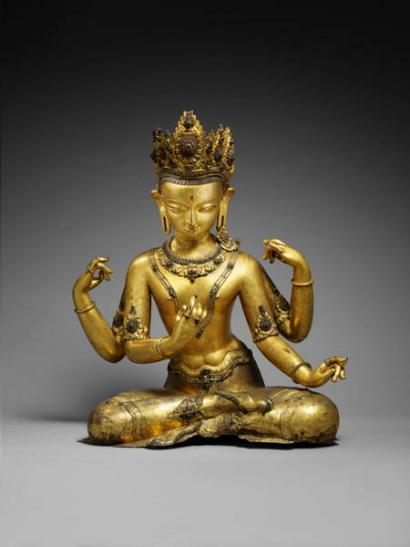
Vishnu, Nepal, 16th Century, gilded copper. Donation 2012. Photo © RMN-Grand Palais (musée Guimet, Paris) / Thierry Ollivier. |
|
MUSÉE NATIONAL DES ARTS ASIATIQUES – GUIMET
6, place d’Iéna 75116 Paris
INFORMATION
• Phone: +33 (0)1 56 52 53 44
• Website: www.guimet.fr/en
• Subway: Iéna, Trocadéro, Boissière
• Bus: n°30, 32, 63, 82
OPENING TIMES
Open every day, except Tuesdays, from 10am to 6pm.
ENTRANCE FEES
Combined ticket only (temporary exhibitions and permanent collections):
• Full fare: €9.50
• Reduced fare: €7
CURATORSHIP
Sophie Makariou, general curator and president of the MNAAG
PRESS CONTACT
Hélène Lefèvre, Head of Communication
• Phone: +33 (0)1 56 52 53 32
• E-mail: helene.lefevre@guimet.fr

|
A universal resource
Gold is preeminent throughout the Asian continent. Present in Buddhist symbolism, Tantric Buddhism, and slightly less in Hinduism and Jainism, the glowing metal could only be displayed in a large-scale exhibit, after jade recently shown in its multiple aspects. Unlike for that presentation that called upon many loans, the Musée national des arts asiatiques – Guimet chose to examine its own collections – including some pieces drawn from its deposits, restored, or recently acquired – to form an ensemble of 113 masterpieces. It is with a goldsmith’s eye that the MNAAG explores and situates the exchanges of the inalterable metal and the reasons for its rarity, whether it be gold powder in Japan, China, or Korea, coin issues in Kushanid Afghanistan, or jewellery for the Indian maharajas. The techniques of gold extraction and its workmanship will be presented in an introduction, before a treasury of splendours will narrate its fabulous epic, the reasons for its appeal and the power of seduction it exerted in Asia, a thousand and one golden tales spun around 113 pieces.
Gold, eternal
A tribute paid to the relics of defunct masters, images of worshipped beings, or ritual objects on altars, gold was highly sought after for the perfect purity demanded by the Buddhist Law. Moreover, it was Buddhism that opened for it vast horizons steeped in symbolism: how could Buddha’s glowing complexion be evoked better than with gold? A conveyor of eternity, gold played a leading role in funerary adornment as in the preservation of memory, offering statuary the opportunity to strikingly express these unifying factors on the scale of the Asian continent, so that when gold was lacking, bronze or gilt wood replaced it.
When gold, frequently mentioned, was glorified in the sutras, the patched garments of the historic Buddha’s companions became pretexts for creating lavish gold-striped patchworks, similarly to the gold in the garb of Lucknow, Mughal India’s last stronghold. A promise of eternity, gold defies human time and performs the transition: did not the emperor of China, Qianlong, for his eightieth birthday, have his own writings on ethics and political philosophy calligraphed in gold ink on jade plaques?
Symbol of power and wealth
Invested with the symbolism of power and wealth, gold and its splendours are evoked through archaeological material but also the production of luxury items in Mughal India. In Afghanistan, under the Kushanid dynasty (1st-3rd Century), gold coin issues appeared, recalling the irruption of nomads in the sedentary world, expressing thereby the sovereign’s immense prestige and might, the Altai Mountains being the source of gold. Echoing the world of the steppes, several archaeological pieces, like the typical crown of the Silla Kingdom (5th-6th Century) from a tomb of Kyongun in Korea, attest the importance of pomp at the time of the Three Kingdoms.
In Japan, gold adds grace to the dazzling lacquer pieces, screens, and textiles of the acme of the upper class, the most refined and most frivolous of the floating world, recalling here that fascination for the magic metal does not invalidate the old saying: “all that glitters is not gold”.
PUBLICATION
• 113 Ors d’Asie, exhibition catalogue, a co-edition Silvana Editoriale and musée national des arts asiatiques – Guimet, under the direction of Sophie Makariou, general curator and president of the MNAAG. Hardcover, 216 pages, 150 illustrations, €35.
|









